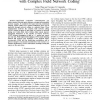Free Online Productivity Tools
i2Speak
i2Symbol
i2OCR
iTex2Img
iWeb2Print
iWeb2Shot
i2Type
iPdf2Split
iPdf2Merge
i2Bopomofo
i2Arabic
i2Style
i2Image
i2PDF
iLatex2Rtf
Sci2ools
CISS
2007
IEEE
2007
IEEE
High-Throughput Cooperative Communications with Complex Field Network Coding
Relay-based cooperative communications can achieve spatial diversity gains, enhance coverage and potentially increase capacity. If considered for large networks, traditional relaying scheme suffer from spectral inefficiency that can be improved through network coding at a physical layer. These considerations motivate the complex field network coding (CFNC) scheme proposed in this paper. As opposed to network coding over Galois field, where wireless links cannot improve throughput limitations as the number of sources increases, CFNC achieves throughput as high as 1/2 symbol per source per time slot. With improved throughput, CFNC-based relaying achieves full diversity gain regardless of the channel signalto-noise-ratio (SNR) and the underlying constellation, and is general enough to incorporate transmissions from sources to a common destination as well as information exchange among the sources at the same time.
| Added | 02 Jun 2010 |
| Updated | 02 Jun 2010 |
| Type | Conference |
| Year | 2007 |
| Where | CISS |
| Authors | Tairan Wang, Georgios B. Giannakis |
Comments (0)

